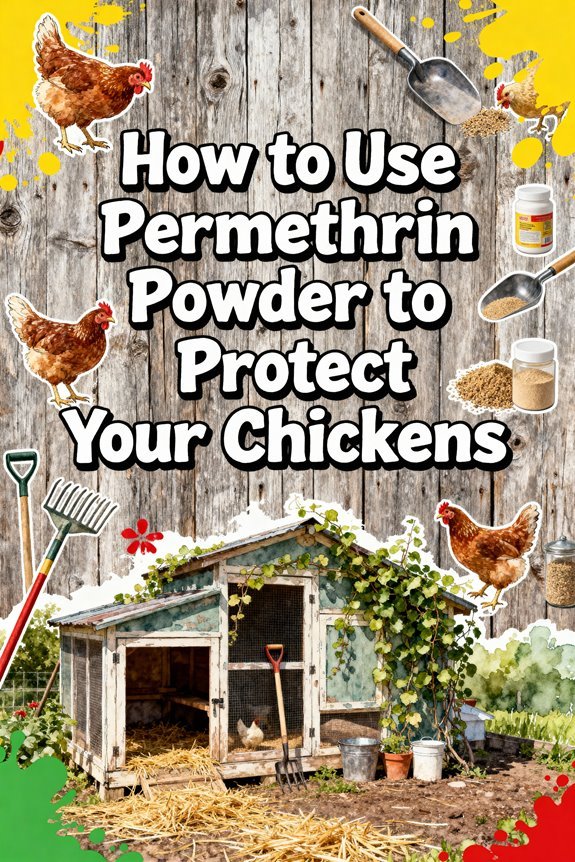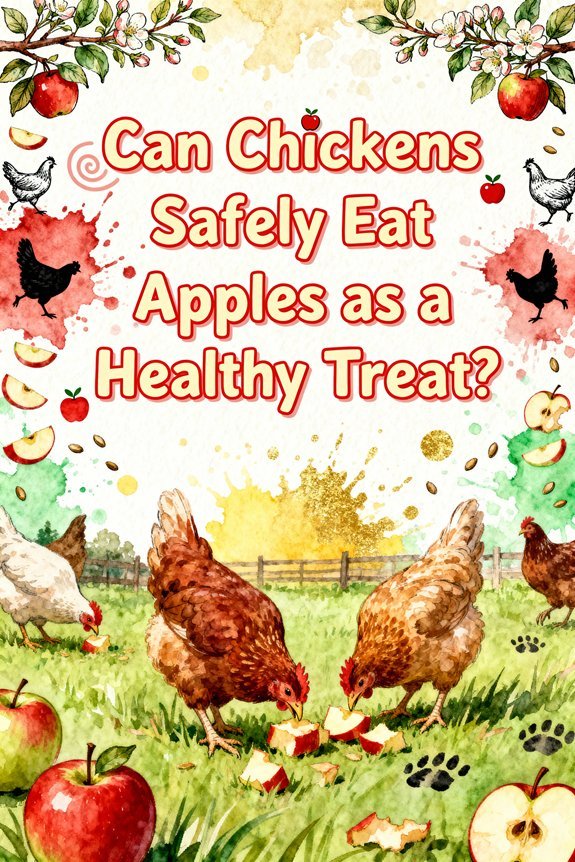Can Chickens Safely Eat Tomatoes in Their Diet?
Yes, your chickens can safely eat ripe tomatoes as part of their diet, but you’ll need to remove all green parts including stems, leaves, and flowers to prevent solanine toxicity. Offer diced tomatoes 2-3 times weekly, providing about a handful per 6-8 chickens. The fruit’s vitamins, minerals, and antioxidants can enhance egg quality and overall health. Understanding proper preparation and serving guidelines guarantees your flock receives maximum nutritional benefits while avoiding potential risks.
The Safety of Feeding Tomatoes to Chickens
While chickens can safely consume ripe tomatoes as part of their diet, understanding proper feeding guidelines is crucial to prevent potential toxicity risks. Different tomato varieties, from cherry to beefsteak, are safe when fully ripened to a bright red color. However, you’ll need to remove all green parts, including stems, leaves, and flowers, as they contain dangerous levels of solanine. Providing tomatoes as treats offers chickens a valuable source of vitamins and lycopene to support their health.
Based on chicken preferences, you can offer tomatoes raw, cooked, or processed as sauce or juice. When introducing tomatoes to your flock, monitor their response carefully. Never feed moldy or rotten tomatoes, as they can cause illness. A proper serving consists of about a handful of diced tomatoes for 6-8 chickens, offered up to twice weekly. Ripe tomatoes can also contribute to improved egg quality when fed as part of a balanced diet. Like peppers, tomatoes are nightshade plants, but solanine concerns are minimal when chickens eat only the ripe fruit in typical amounts. This moderation guarantees your chickens receive the nutritional benefits without disrupting their primary diet.
Understanding Solanine Toxicity in Tomatoes
Most chicken owners must understand solanine toxicity when feeding tomatoes to their flock, as this naturally occurring glycoalkaloid poses significant health risks. The highest concentrations of solanine appear in tomato stems, leaves, and unripe fruits, where it can trigger severe toxicity symptoms in chickens. Providing balanced commercial feed as the main diet helps minimize accidental exposure to toxic plant parts.
Solanine effects range from mild to potentially fatal. You’ll notice initial symptoms like diarrhea and nausea in affected birds, which can progress to more serious conditions including respiratory distress, arrhythmia, and neurological complications. In severe cases, the toxin can cause internal bleeding, paralysis, or death. The toxic threshold is approximately 2.5 mg/kg of body weight, though chickens are particularly vulnerable due to their size. While ripe tomato fruits are safe for consumption, you must remove all stems and leaves before feeding them to your flock. Similar to other safe vegetables like zucchini, tomatoes should be fed in moderation and introduced gradually to prevent digestive upset in your birds. Proper nutrition plays a critical role in maintaining hen health and egg production, regardless of whether a rooster is present in the flock.
Essential Nutrients Found in Tomatoes for Chickens
Since tomatoes provide a rich array of essential nutrients, you’ll find them to be a valuable dietary supplement for your chickens’ health and development. The nutrient benefits include important vitamins C, A, and K, which support immune function, vision health, and blood clotting respectively. You’ll also find significant vitamin content in the form of folate and B9, essential for cellular processes and metabolism.
The antioxidant profile, featuring lycopene, beta-carotene, and lutein, helps protect your flock’s cells from oxidative stress while supporting heart and eye health. Necessary minerals like potassium aid in nerve function and muscle contractions, while the high water content (90%) assists with hydration. These nutrients can enhance egg quality, producing more nutritious eggs with improved yolk color and antioxidant properties. Similar to how dietary fiber supports digestive function in chickens when they consume persimmons, tomatoes offer complementary nutritional benefits that promote overall health. You can also incorporate tomatoes into homemade chicken treats alongside wholesome ingredients like oats, sunflower seeds, and grains to create nutritious supplements for your flock. Offering tomatoes once or twice weekly as treats ensures your chickens receive these benefits without disrupting their balanced diet.
How Tomatoes Impact Egg Production
As layers consume tomato supplements in their diet, you’ll observe measurable impacts on egg production metrics and quality parameters. Studies demonstrate that adding tomato powder (2-10g/kg feed) leads to increased egg production benefits, with improved laying persistence and feed conversion ratios. Adding fresh ripened tomatoes provides essential vitamins C, E, and K that support overall hen health.
You’ll notice enhanced egg quality through carotenoid enrichment, particularly in yolk characteristics. The lycopene and other antioxidants from tomatoes result in deeper yolk coloration and reduced lipid peroxidation, extending shelf life. While some research shows variable effects on production rates, the overall impact remains positive for egg mass and nutrient content. Ensuring your hens have access to nesting boxes in a well-designed coop helps maximize both production efficiency and egg quality when feeding supplemental tomatoes.
Despite concerns about tomato acidity affecting calcium metabolism, research indicates no significant negative effects on eggshell thickness or weight, though some studies suggest minor decreases in shell strength when using tomato waste products. Like marshmallows, treats should be offered in moderation to maintain a nutrient-rich diet focused on optimal laying performance.
Best Practices for Feeding Tomatoes to Your Flock
When feeding tomatoes to your backyard flock, proper preparation and portion control become essential for maximizing nutritional benefits while avoiding potential health risks. You’ll need to select fully ripe, red tomatoes, thoroughly wash them, and cut them into manageable pieces. Remove all plant parts, including leaves and stems, as they contain toxic solanine. Cooking is optional since both raw and cooked tomatoes provide equal nutritional value to chickens.
Maintain a consistent feeding schedule by offering tomatoes as treats two to three times weekly. You’ll want to integrate them within a broader treat variety alongside other safe vegetables like carrots and cucumbers. Monitor your flock’s response and remove any uneaten portions promptly to prevent pest attraction. Keep portions small enough that they don’t interfere with regular feed consumption, and increase amounts moderately during colder months to support energy needs. Additionally, watch for any signs of decreased egg production or behavioral changes in your chickens, as these can indicate dietary issues or other health concerns that require attention.
Signs of Tomato-Related Health Issues in Chickens
While tomatoes can provide nutritional benefits to chickens, they may also trigger concerning health issues that require prompt attention. Symptom identification focuses on four key areas: digestive disturbances, neurological effects, respiratory problems, and behavioral changes. Watch for diarrhea, vomiting, and loss of appetite as primary gastrointestinal indicators. Neurological symptoms include muscle tremors, incoordination, and dilated pupils. You’ll notice respiratory distress through labored breathing, while behavioral changes manifest as reduced feed intake and social withdrawal. These symptoms typically emerge within hours to days after consuming toxic tomato plant parts or unripe tomatoes. The severity varies based on exposure amount and individual susceptibility. If you observe these signs, remove tomato access immediately and seek veterinary care, especially for severe cases involving convulsions or extreme lethargy. Although chickens often possess instinctive avoidance of toxic plants, hunger may drive them to consume harmful tomato plant parts.
Proper Preparation Methods for Tomato Treats
Preparing tomato treats safely for your chickens requires careful attention to selection and handling protocols. When considering tomato variety selection, choose fully ripened, bright red specimens with a sweet aroma and slight give when pressed. You’ll need to thoroughly wash the tomatoes and remove all green parts, including stems and leaves, due to their toxic solanine content.
Cut the tomatoes into small, manageable pieces that align with your chickens’ taste preferences. You can serve them raw or cooked, though cooking may enhance digestibility. Don’t add seasonings or salt when preparing cooked versions. While seeds and skins are safe for adult birds, they’re best avoided for chicks under 8 weeks old. Source your tomatoes from reliable vendors and discard any showing signs of spoilage to guarantee maximum safety. Maintain feeding frequency to twice a week to prevent overconsumption and maintain a balanced diet.
Recommended Serving Sizes and Frequency
To maintain ideal nutrition for your flock, tomatoes should constitute no more than 10% of their total feed intake during any serving session. Offer a handful of bite-sized tomato pieces per chicken, limiting feeding frequency to 1-2 times weekly as treats. High tomato consumption can cause egg quality changes in laying hens.
When determining serving sizes, you’ll need to adjust proportionally for your flock’s size while maintaining the 10% limit. Monitor free-range chickens who may access tomato plants directly, and make sure they don’t overconsume. For chicks under 6-8 weeks, avoid feeding tomato skins or raw tomatoes due to digestive concerns. ISA Brown chickens, known as prolific layers, can produce up to 300-350 eggs annually and may be particularly sensitive to dietary imbalances that affect egg production.
Your chickens may require increased food intake during colder months, but don’t exceed the recommended tomato serving frequency. Instead, rotate tomato treats with other safe fruits and vegetables to maintain dietary balance and prevent dependency on any single treat type.
Monitoring Your Chickens After Tomato Consumption
After introducing tomatoes into your chickens’ diet, careful observation becomes essential for detecting potential adverse reactions. Your symptom monitoring should focus on digestive issues like diarrhea, vomiting, or changes in dropping consistency. Watch for behavior changes including reduced activity, loss of appetite, or unusual lethargy.
Pay particular attention if your chickens consume unripe tomatoes or plant parts, as these contain toxic alkaloids. Signs of toxicity include tremors, excessive drooling, or neurological symptoms. If you notice multiple birds displaying symptoms simultaneously, remove all tomatoes immediately and provide clean water and bland feed. Feeding ripe tomatoes provides chickens with beneficial vitamin C and antioxidants that support their immune function.
Document your observations systematically, including feeding amounts and timing. If symptoms persist or worsen, isolate affected birds and consult a veterinarian. Keep detailed records to track individual tolerance levels for future dietary management.

